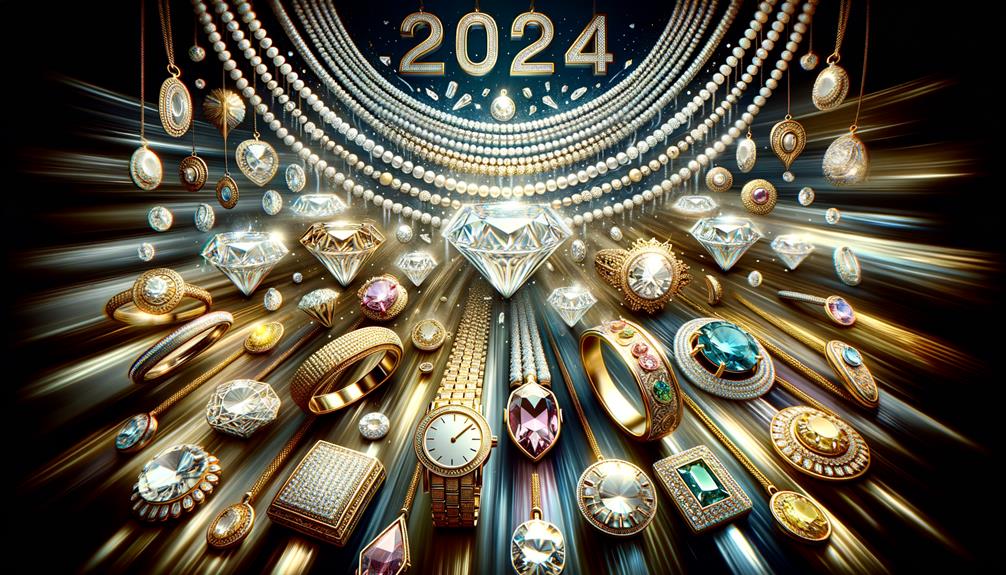What Is Our Luxury Jewelry Market Forecast for 2024?
As we look towards the future, the luxury jewelry market—characterized by its dynamic nature—promises intriguing possibilities.
Several key trends, including the increasing purchasing power of consumers, innovative design aesthetics, and the growing influence of online retail, are projected to drive market expansion significantly during 2024.
However, with this growth come potential obstacles, such as the threat of e-commerce fraud and a prevalent lack of consumer awareness about jewelry authentication.
As we examine the future of this vibrant industry, it becomes increasingly clear that a keen understanding of these trends and challenges will be paramount for those seeking to navigate and capitalize on the luxury jewelry market.
Article Contents
- 1 Key Takeaways About Our Jewelry Market Forecast
- 2 Projected Jewelry Trends for 2024
- 3 Challenges to Luxury Jewelry Growth
- 4 Digital Impact on Jewelry Market
- 5 Key Players in Luxury Jewelry
- 6 Regional Market Analysis
- 7 Frequently Asked Questions
- 8 Our Jewelry Market Forecast Conclusions
- 9 Further Reading About Our 2024 Jewelry Market Forecast
Key Takeaways About Our Jewelry Market Forecast
- Shift towards modern-day heirloom pieces and unique combinations of materials in luxury jewelry.
- Increasing demand for personalized designs and emphasis on high-quality, meaningful items.
- Digital impact on the jewelry market with increased online presence, social media marketing, and virtual try-on technology.
- Key players in luxury jewelry focus on exclusive offerings, ethical sourcing, sustainability, and engaging in celebrity collaborations for promotion.
Projected Jewelry Trends for 2024
In an evolving landscape of style and consumer preferences, the projected jewelry trends for 2024 signal a distinct shift towards modern-day heirloom pieces, unique combinations of intriguing materials, and an emphasis on high-quality, meaningful items that resonate with buyers on a personal level.
The rising demand for luxury items, spurred by increasing disposable income and changing lifestyles, is anticipated to influence these trends significantly. The luxury goods market trends indicate a growing preference for experiential luxury, with consumers valuing unique and personalized experiences over material possessions. Additionally, there is a notable shift towards sustainability and ethical consumption in the luxury sector, with more consumers seeking out brands that prioritize environmental and social responsibility. These shifts in consumer behavior are expected to shape the future of the luxury goods market, driving innovation and creating new opportunities for brands to connect with their target audience.
Material innovation, particularly in sustainable jewelry, is expected to be a crucial factor. Consumers are increasingly drawn towards eco-friendly materials, reflecting a heightened awareness of environmental impact.
Personalized designs are also gaining popularity, with buyers seeking unique pieces that symbolize their individuality and experiences. As such, the market will likely see an influx of intricate, bespoke designs marrying traditional aesthetics with contemporary craftsmanship.
Additionally, gemstone trends are set to evolve, moving away from conventional diamonds to embrace a wider variety of precious and semi-precious stones. These stones, revered for their unique colors and properties, add a layer of meaning and exclusivity to the pieces.
The 2024 jewelry landscape, thus, is poised to be a perfect blend of tradition and innovation, individuality and sustainability.
Challenges to Luxury Jewelry Growth

Despite the promising forecast for the luxury jewelry market, several obstacles, ranging from a lack of innovation to inventory shortages, pose substantial challenges to its growth trajectory.
Inventory management is becoming increasingly problematic for major retailers like Saks and Neimans. Limited stocks can lead to missed opportunities, affecting both consumer satisfaction and revenues. The unpredictability of demand in the luxury market makes it even harder to maintain a healthy inventory.
Another significant hurdle lies in customer engagement. Transactional disengagement is growing, with consumers demanding more personalized and meaningful brand interactions. A related concern is the erosion of brand loyalty as the market struggles to inspire continued consumer support and recommendations.
Innovation barriers also pose a serious threat. The lack of creativity across categories stifles growth as consumers crave unique, trend-setting designs. Additionally, pricing challenges are becoming more acute. Excessive price hikes, particularly in the watch sector, are threatening to deflate the luxury bubble for the ultra-wealthy.
Overcoming these obstacles will be critical for the luxury jewelry market to sustain its projected growth into 2024.
Digital Impact on Jewelry Market
While addressing the challenges to luxury jewelry growth remains critical, it is equally important to consider the profound impact of digital transformations on the jewelry market. The escalating online presence of luxury brands and expansive social media marketing strategies have revolutionized how consumers perceive and purchase luxury jewelry.
E-commerce platforms have become a pivotal sales conduit, providing consumers with an array of choices, competitive pricing, and the convenience of shopping from home. However, the mere availability of jewelry online is no longer sufficient. Brands are investing in digital advertising, leveraging data analytics to target potential consumers and create personalized shopping experiences.
Furthermore, innovations like virtual try-on technology are enhancing the online shopping experience, bridging the gap between physical and virtual retail. Consumers can now visually experience the product, reducing uncertainty and boosting confidence in online purchases.
The digital transformation of the jewelry market is not just a passing trend but a fundamental shift. The brands that can seamlessly integrate their physical and digital presence, leveraging both to create a holistic and engaging customer experience, are poised to thrive in the forecast period leading up to 2024.
Key Players in Luxury Jewelry

Dominating the luxury jewelry landscape, Rolex, Cartier, and Tiffany & Co. are key players renowned for their high-quality and exclusive offerings, catering to the ultrawealthy demographic with their iconic pieces and timeless designs. These luxury brands differentiate themselves by focusing on craftsmanship and heritage and ethical sourcing, ensuring the materials used are obtained responsibly.
These companies also offer customization options, allowing consumers to personalize their jewelry, thus creating a unique sense of belonging. To further their market reach, they frequently engage in celebrity collaborations, leveraging the influence of high-profile individuals to promote their products.
Sustainability is another significant focus for these key players. From using sustainable materials to promoting recycling, these brands are setting the standard for environmental consciousness in the luxury jewelry industry.
Regional Market Analysis
In evaluating the luxury watches and jewelry market on a regional scale, it is anticipated that by 2024, the industry will reach a revenue of US$12.88bn, with an annual growth rate of 7.53% projected to result in a market volume of US$17.22bn by 2028. Consumer preference differences, market segmentation, and regional growth factors are the main causes of variations in regional market performance.
The competitive landscape of the luxury jewelry market is intensely diversified and competitive, with market opportunities emerging from novel designs and online marketing. Socioeconomic conditions, cultural influences, and consumer preferences are just a few of the regional growth factors that have an impact on this landscape.
| Region | Market Opportunities | Regional Growth Factors |
|---|---|---|
| North America | Expansion of online platforms | High disposable income |
| Europe | Innovative designs, Bridal jewelry | Luxury culture |
| Asia-Pacific | Silver jewelry, Online market | Rising middle class |
Market segmentation according to regions helps businesses target specific consumer preferences and needs. For instance, the rising middle class in the Asia-Pacific region presents a significant market opportunity for luxury jewelry, while the high disposable income and luxury culture in North America and Europe continue to drive market growth.
Frequently Asked Questions
What Is the Trend in Jewelry in 2025?
We anticipate that in 2025, online retailing, technological integration, personalized designs, and sustainable sourcing will all have an impact on the jewelry market. We expect to see a revival of vintage styles, catering to consumers’ desire for uniqueness and ethical consumption.
What Is the Future of the Jewelry Industry?
Sustainable business practices, technological advancements, and emerging markets will influence the future of the jewelry industry. Brand authenticity and customization trends will also play significant roles in the industry’s evolution and growth.
What Is the Market Potential for the Jewelry Industry?
The jewelry industry’s market potential is promising, driven by gemstone popularity, customization demand, and sustainable jewelry. However, e-commerce influence presents both opportunities and market challenges that businesses must navigate to ensure success.
What Is the Outlook for Jewelry Sales?
Sales strategies, consumer behavior, pricing impact, and regional differences will shape jewelry sales outlook. However, industry challenges like e-commerce fraud could hinder growth. Innovative designs and changing lifestyles are key factors driving market expansion.
Our Jewelry Market Forecast Conclusions
In conclusion, I believe that the luxury jewelry market is undergoing several trends and challenges that will shape its future. We are observing a shift towards modern-day heirloom pieces, unique combinations of materials, and an increasing demand for personalized designs and high-quality, meaningful items. We are also witnessing material innovation, particularly in sustainable jewelry, reflecting a heightened environmental awareness. Additionally, there is a growing popularity of personalized designs that symbolize individuality and experiences, as well as an evolving gemstone trend that embraces a wider variety of precious and semi-precious stones. Vintage styles are also making a comeback.
However, we must overcome several challenges for sustained growth in the luxury jewelry market. Retailers face issues with inventory management, and there is a risk of transactional disengagement and erosion of brand loyalty. We must recognize the importance of creativity and innovation in driving growth and understand that excessive price hikes in the watch sector pose pricing challenges. Overcoming these obstacles will be crucial for success in the industry.
The digital impact on the jewellery market is significant, and we need to continue working on establishing an escalating online presence and expansive social media marketing strategies. Our e-commerce platforms provide choices, competitive pricing, and convenience for our customers. Businesses have made investments in digital advertising and data analytics to enhance their marketing efforts. We should continue to embrace innovations like virtual try-on technology and have these tools seamlessly integrated our physical and digital presence.
Players in the luxury jewelry market should focus on craftsmanship, heritage, and ethical sourcing. Vendors must offer customization options and collaborate with celebrities to provide unique, personalized designs. Sustainability and recycling are also important aspects of brands, and brands should continue to increase their commitment to promoting ethical practices.
Looking ahead, I believe that the outlook for jewelry sales is promising. The popularity of gemstones and the rising demand for customization drive the market potential. However, we acknowledge that the influence of e-commerce presents challenges, and we understand that innovative designs and changing lifestyles will be the key drivers of market expansion. We should be committed to sustainability and maintaining brand authenticity and recognize these factors as crucial for success in the industry.
Further Reading About Our 2024 Jewelry Market Forecast
1: https://www.statista.com/outlook/emo/luxury-goods/luxury-watches-jewelry/worldwide
2: https://www.jckonline.com/editorial-article/state-of-the-luxury-market-2024/
3: https://www.matterofform.com/news/articles/jewellery-industry-trends
4: https://www.mckinsey.com/industries/retail/our-insights/state-of-fashion
5: https://www.grandviewresearch.com/industry-analysis/jewelry-market






